Syria
Resolution
After the August 21, 2013 sarin gas attack near Damascus in
Syria, the Zetas predicted the outcome. It would be announced
that the rebels did it, and no attack on Syria would occur.
ZetaTalk Prediction
8/31/2013: The
use of poison gas in Syria was arranged by Israel. Of course
it wasn’t Israeli soldiers. Of course they were very much
behind the scenes in supplying the rebels. Not just a hand
away, but many hands away, so that it would be impossible,
literally, to trace where the gas came from. This is arranged
by killing those intermediaries. And why did they do this? If
the US gets involved in Syria, it will bleed over, they hope,
into Iran. Iran has been backing Assad. The US will fight
their war and they can go on taking land from the
Palestinians. Everybody will look away and they will have the
US as their own private army. Will this ever be proven? No.
Will this be suspected? Yes. So therefore, a war will not be
started here. Assad it not going to be pummeled by the US. It
will be announced that it was a false flag, the rebels did it.
This is nothing different than has already been announced in
previous times.
This had certainly been the case in prior incidents. The March
19, 2013 incident near Aleppo was demonstrably the doing of the
rebels.
- Russia: Syrian Rebels Made, Used Sarin
Nerve Gas
July 9, 2013
http://www.cbsnews.com/8301-202_162-57592880/russia-syrian-rebels-made-used-sarin-nerve-gas/
- The results of the analysis
indicate the Bashar 3 rocket was not industrially
manufactured and was filled with sarin. The samples
indicated the sarin and the projectile were produced in
cottage industry conditions. The absence of chemical
stabilizers, which are needed for long-term storage and
later use, indicated its possibly recent production.
Therefore, there is every reason to believe that it was
the armed opposition fighters who used the chemical
weapons in Khan al-Assal.
- Russia Releases Key Findings on
Chemical Attack near Aleppo Indicating Similarity with
Rebel-Made Weapons
September 4, 2013
http://rt.com/news/chemical-aleppo-findings-russia-417/
- Chemicals used in the March 19
attack did not belong to standard Syrian army ammunition,
and the shell carrying the substance was similar to those
made by a rebel fighter group.
Where the US media, in support of Obama, reiterated the
conclusion that it was Syria under Assad that was responsible in
Damascus, the US intelligence community was hardly of that
opinion. And all the compelling evidence that the rebels had yet
again done the deed was being ignored.
- Rebels 'Making Chemical Arms' In Syria
September 9, 2013
http://wwwwakeupamericans-spree.blogspot.com/2013/09/bombshell-rebels-making-chemical
- The chemical weapons were
allegedly produced by an individual person in the ranks of
the Syrian Al-Qaeda offshoot – Hani Nour Eldin Aqeel. The
poison gas / chemical weapons was produced in a workshop
of the al-Nusra Front in the Syrian city of Yabroud.
Afterwards, the poison gas (e.g. Sarin nerve gas) was
transported to the city of Douma in domestic gas capsules,
which are not uncommon in Syria. The report itself was
published by the Arab news website Asianews.
- Obama's Case for Syria Didn't Reflect
Intel Consensus
September 9, 2013
http://truth-out.org/news/item/18702-obamas-case-for-syria-didnt-reflect-intel-consensus
- U.S. intelligence officials have
long been doubtful about intelligence from Israeli sources
that is clearly in line with Israeli interests.t
- Chemical Attack was Syria Rebel
Provocation, Former Hostages Say
September 10, 2013
http://rt.com/news/chemical-weapons-rebels-captives-632/
- The former hostages - Belgian
teacher Pierre Piccinin and Italian journalist Domenico
Quiric - said they overheard an English-language Skype
conversation between their captors and other men which
suggested it was rebel forces, not the government, that
used chemical weapons on Syria’s civilian population in an
August 21 attack near Damascus.
Then why did Obama take this stance, insisting the Assad
government did the deed? This was false posturing, per the
Zetas, to offset an anticipated attack by Israel and the banking
industry, in conjunction with the cover-up crowd, to claim Obama
is so weak that he invented Nibiru as a claim to distract the
public. This was to gut the announcement, and in essence
continue the cover-up. Will this work? Per the Zetas, they lost
the game almost immediately, as Obama did a complete about face
and became a hawk, knowing that Congress and the American people
and the UN would not allow him to attack Syria.
ZetaTalk Insight
9/7/2013: Are
Obama and Biden and Kerry playing a game, appearing to be as
dumb as an ox about the “evidence” they have that Assad did
it? Why is Obama stopping just short of rushing into
another Middle East war when he has always been cautious about
this and trying to extract the US from these conflicts? This
seeming personality change on the part of Obama, a complete
about face on keeping the US out of Middle East conflicts, and
complete loss of insight and balance on who might be
responsible and what steps to take (such as waiting for the UN
inspection results) is puzzling.
But it is an act, a chess
game of the highest order. By becoming a hawk, in a very safe
environment, Obama has stymied their argument that he is a
weak president trying to create a distraction with the
announcement. Any argument that Obama has invented
Nibiru to get a weak President off the hotseat will have been
countered, as Obama appears the strong one. We have described
bait and switch techniques being used to catch the cover-up
crowd in the US. This is an example of a feign and switch, a
maneuver opposite of what is intended or expected while the
real maneuver is taking place, unnoticed.
Antarctic Plate Roll
Seismologists clueless about the Antarctic Plate roll are
puzzling over a phenomenal increase in earthquakes in Gippsland,
Australia. This region, above Tasmania, is where exceptionally
high waves were recorded recently, puzzling
meteorologists. This was outlined in Issue
362 of this newsletter on September 8, 2013 where the
Zetas explained that the Antarctic Plate was rolling in a
clockwise manner, hooking the Australian Plate. Now yet
more evidence is in hand that the bulge on the Antarctic Plate
is indeed pushing against the Tasmania region. Gippsland is just
above Tasmania, the same region that experienced high waves last
August.

- Scientists Study Gippsland Earthquake
Hotspot
September 10, 2013
http://www.abc.net.au/news/2013-09-10/scientists-study-gippsland-earthquake-hotspot/4948878
- Scientists in Victoria are
attempting to learn more about the increase in the number
of earthquakes in the Gippsland region. There were only 50
earthquakes recorded up until 2009, but since then there
have been 700. The activity has been particularly high in
the Strzelecki Ranges which lie between the Latrobe Valley
and the Gippsland coastline.
ZetaTalk Explanation
8/24/2013: Due
to the S American roll, which is caused by the spreading
Atlantic, there is a natural tendency of the Antarctic Plate
to roll clockwise, pushing the tip of S America toward Africa.
We have mentioned that the compression in the Pacific Plates
tips the Antarctic Plate also, which ultimately results in new
land emerging between the tips of S America and Africa. As
this roll of the Antarctic Plate begins, it will also tend to
push under the Indo-Australian Plate, which is in any case
lifting on its eastern edge and thus providing an opening for
the Antarctic roll. If such a nudge up occurs, the water atop
the Indo-Australian Plate will slosh, and this is what
occurred on August 19 near Tasmania.
Louisiana Sinkhole
Growing
The Bayou Corne sinkhole has been growing steadily over this
past year, no end in sight!

This was first covered in this newsletter in Issue
309 on September 2, 2012 and again in Issue
347 on May 26, 2013. On August 21, 2013 the sinkhole ate
several large trees in dramatic fashion, all caught
on video.
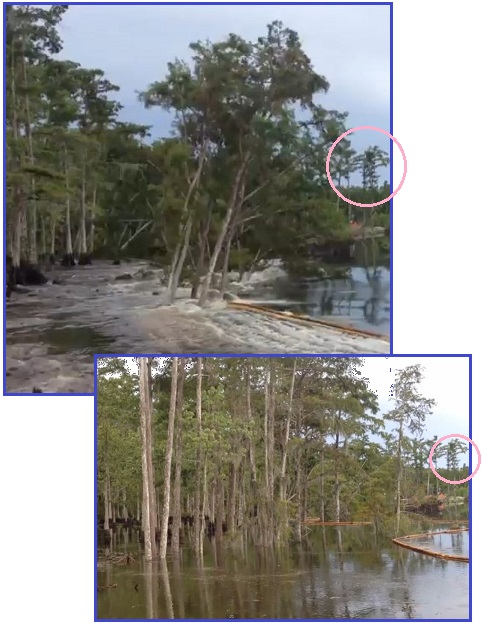
- Relentless Bayou Corne Sinkhole Nearly
30 Times Original Size
August 21, 2013
http://www.opednews.com/articles/Relentless-Bayou-Corne-Sin-by-Meryl-Ann-Butler-130821-798.html
- A year after the largest sinkhole
ever documented appeared, the cavity is almost 30 times
larger, and containment does not appear to be any closer.
The Bayou Corne Sinkhole is currently at least 28 acres in
size, and still growing.
As the Zetas warn, given the bowing of the N American
continent and the pending New Madrid adjustment, the Salt Dome
caverns used to store petroleum are going to continue to
rupture. And it is not just Bayou Corne that will be
affected.
ZetaTalk Warning
12/15/2012: It
is more than just that sinkhole, as numerous salt dome caverns
used to store petrol products are in use in the region.
Making Garments
In times gone by, garments were made by hand, from natural
materials. Now they are as likely to be made from synthetic
material, poured into molds, and those who purchase modern
clothing and bedding from stores are clueless on how to make
replacements. After the Pole Shift, survivors in industrialized
countries will be thrown back to a lifestyle prevalent centuries
ago. What will you do when your shoes are in pieces and your
clothing is in shreds? It’s really not that complicated! Start
your education by learning about natural fibers and materials.
Familiar and easily obtained materials are wool from sheep or
shaggy animals, cotton, and flax fibers for weaving into linen.
All are amenable to being combed into long fibers, in
preparation for being spun into yarn or thread. Wool is washed
to remove dirt and oils, linen soaked to rot away plant material
from the fibers, and cotton simply cleaned of husks and seeds.
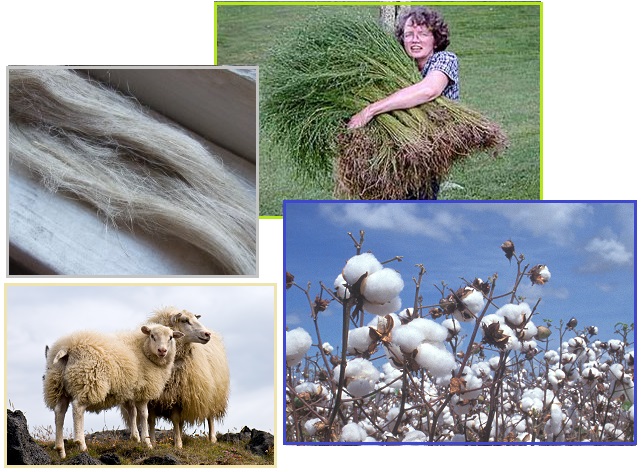
Since wool tightens and shrinks when heated, a type of cloth
called felt can be made from small scraps. The felting process
is to lay wool fibers in different directions, then pour boiling
water over the lot. Felt is durable and wet felt can be formed
into slippers. After being spun into yarn, fibers such as wool
can be knitted into garments using a pair of knitting needles or
crocheted via a crochet hook. Transforming natural materials
into clothing in this way has been done by idle hands in the
evenings around the fire for centuries.
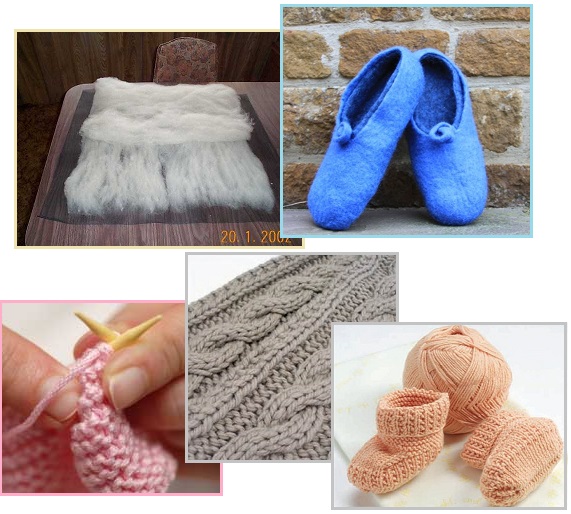
- Felting
http://www.drycreekrandr.com/felt.html
- Felting is boiling wool so that it
shrinks and tightens the fibers. The boiled wool must be
spread out to dry, into sheets or formed into slippers or
other objects. Then dried.
Curing leather to be used in coats or shoes or chaps is messy
at first, because the leather must be scraped clean. There are
many chemicals used for curing leather, but one survivors are
almost certain to be able to obtain is the time honored tannin
from the bark of many different trees. Some rivers even owe
their dark brown color not to mud but tannin from trees
upstream. That’s the case for the Baraboo River that flows past
my house here in Wisconsin, for instance. Soaking the leather in
a mash from the brains of the animal is another tanning
technique.
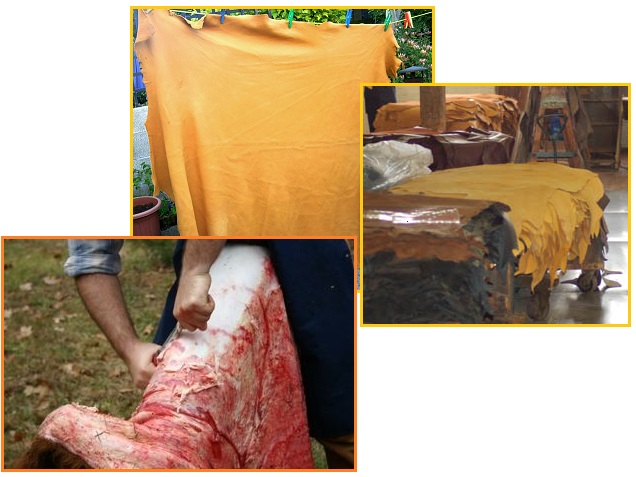
- Tanning Hide Views
http://www.red-grey.co.uk/general/tanning-hide.html
- Vegetable tanning uses tannin
(this is the origin of the name of the process). The
tannins (a class of polyphenol astringent chemical) occur
naturally in the bark and leaves of many plants. Tannins
bind to the collagen proteins in the hide and coat them
causing them to become less water-soluble, and more
resistant to bacterial attack. The process also causes the
hide to become more flexible. The primary barks, processed
in Bark Mills and used in modern times are chestnut, oak,
redoul, tanoak, hemlock, quebracho, mangrove, wattle
(acacia; see catechu), and myrobalan. Hides are stretched
on frames and immersed for several weeks in vats of
increasing concentrations of tannin. Vegetable tanned hide
is flexible and is used for luggage and furniture.
Most cloth is woven on looms from threads and wool spun into a
fine twist. But leather is just cut into the appropriate sized
pieces. Regardless of whether knitted, woven, or from pieces of
leather, cloth requires needle and thread at some point. This is
for stitching by hand, or by machine. In the future, when
electricity might not be available, a treadle sewing machine is
just the thing. They can be found at yard sales, in barns or
antique stores, for sale on eBay, and even manufactured new
these days.
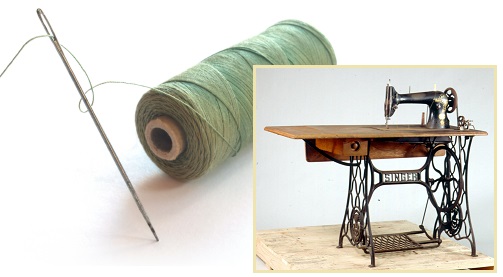
Spinning
One can create string and yarn with just a twirling distaff, or
one can go into rapid production by using a spinning wheel.
VIDEO: http://www.youtube.com/watch?v=F0rCnNL2Xfs
VIDEO: http://www.youtube.com/watch?v=GcrziTxvMRM
Making 3-ply yarn is something that a spinning wheel can
accomplish, as noted below. These drawing were done by Nancy,
and are found on the Troubled
Times site. I, Nancy, inherited my great grandmother
Frederika’s spinning wheel, and learned how to use it. It had a
little bit of thread from her spun flax still on the spindle.
This is not a mystery item, and can easily be constructed by a
carpenter using hand tools!

Spinning a thread, a rope, or a strand of yarn involves three
steps - straightening the material to be spun, putting a twist
in a thin strand of the material, and winding the twisted strand
onto a bobbin. Material to be spun can be any fibrous
material such as wool from animals, flax or cotton from plants,
or silk from silk worms. Preparing the material involves washing
it, and in the case of flax, soaking and working it in water to
remove rotting soft matter from the fibers. The clean fibers are
then combed straight or carded, an action where the fibers are
caught between two flat wire brushes, called cards, and pulled
in opposite directions. In the most primitive form spinning is
done with a distaff and spindle, where the hand-held spindle is
moved in a circle by wrist movements and after a twist is put
into the thread, is wound by hand onto the spindle. This process
is used in one form or another in primitive cultures around the
world.
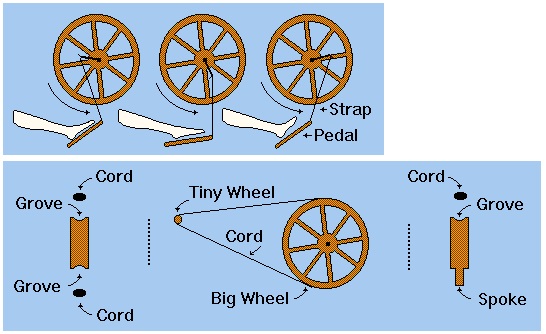
The spinning wheel improves this process, allowing a foot pedal
to create the spin while the hands are free to work with the
material. The foot pedal is attached by a strap to a special
spoke sticking out from the center and to the side of the wheel.
When this special spoke is on the downward side of the circle,
the foot gives a gentle nudge to the foot pedal, encouraging the
motion. When on the upward side of the circle, the foot
releases, allowing the pedal to raise up so as not to slow the
motion of the wheel. There is a groove in the wheel that holds a
cord, and a similar groove in a tiny wheel on the other end of
the Spinning Wheel. The relatively slow motion of the large
wheel thus makes for many turns of the tiny wheel, which is
attached to the bobbin. This bobbin replaces the more primitive
spindle. Enough tension is placed on the cord wrapped around the
wheel and thence to the bobbin so that the cord does not readily
slip on either the wheel or the bobbin. The knot in the cord
should be as smooth as possible.

A portion of the clean and straightened fibers are hooked onto
the pointed end of the bobbin, and the turning motion begun. The
material is first drawn out gradually to a thin thread while
attached to the end of the bobbin. The spinning wheel now is
giving a twist to the thread. The drawing out of the material
should occur simultaneously to the twisting, so that the twist
climbs back toward the receding hand. When the material is
twisted to an arm's length, the thread is allows to wind up
along the length of the bobbin, coming back to the tip for the
next thinning and twisting action. During twisting, a slight
tension holds the thread back from winding on the bobbin.

To prevent unraveling and give added strength, the single ply
thread is spun in the opposite direction, into a three ply
strand. This is done by running single threads between different
fingers of the hand, skipping the twisting step and just winding
onto a large bobbin while turning the wheel in the opposite
direction from the direction used to create the single ply
strands. Unraveling is prevented now because all twists are
blocked by an opposing twist.
Weaving
Once you have thread and yarn, you can weave cloth on a loom.
VIDEO: http://www.youtube.com/watch?v=UI_83Ju7GzE
VIDEO: http://www.youtube.com/watch?v=5ES2xAxQSnc
Looms can be large or small, producing heavy cloth or
something lightweight like linen. The details and drawings below
are again taken from the Troubled
Times site, with the drawings once again done by Nancy.
Yes, I had a loom as well as a spinning wheel, and am familiar
with the workings. Once again, this is an item a carpenter could
construct with hand tools.
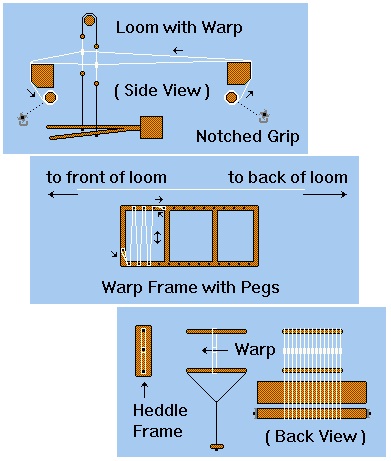
Weaving requires two different threads - the warp and the weft.
The warp is long and strung from the front to the back of the
loom; the weft is laid from side to side during the weaving
process. Looms can be large, several feet wide, or small enough
to be placed on a table. Cloth woven on a small loom can be sewn
together to make a larger piece. The warp is long, runs from the
front of the loom to the back, and is wound around horizontal
wooden bars at the front and back. These bars turn, to wind the
warp at the front end or unwind the warp at the back, by using a
simple notched grip attached to the ends of the bars. The
warp is strung by winding a continuous thread around pegs on a
warp frame. Wind the thread back and forth several times,
creating several warp threads at one time, and then grip the
bunch on both ends and transfer the warp lengths to the loom
frame. This is done repeatedly until the warp is as wide as the
loom or as wide as desired. Make the warp as long as possible,
as the very front and back of the warp can never be woven and
become waste or fringe. The warp threads on the loom are
threaded through heddles, which are also made of string or
thread. A heddle is in essence a small string loop inside a
larger string loop, with the small loop in the middle to hold a
warp thread so it can be raised or lowered during the weaving
process. The heddles are made on a heddle frame composed of
three nails on a board, the top loop tied above the middle nail,
then below the middle nail, then below the bottom nail.
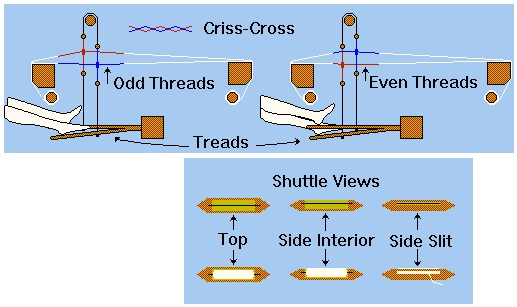
The warp threads are strung through the heddles in the two
heddle racks so that the odd warp threads go through the heddles
on one rack, and the even warp threads go through the heddles on
the second rack. Then, by pressing one tread or the other, the
warp threads are raised and lowered by a pulley action, creating
a criss-cross that secures the weft threads passed back and
forth across the warp. The weft threads are wound onto a bobbin,
a metal rod, that is passed back and forth across the warp
threads inside a shuttle, as though they were sailing across the
warp threads inside a tiny boat. The shuttle is a size that can
be held in the hand, longer than wide, and the wood is smoothed
to avoid snagging during the weaving process. The shuttle has a
rectangle cut from the center where the filled bobbin is placed.
The metal rod of the bobbin is held in place by notches at the
ends of this hole. A slit is cut at the side where the weft
threads unwind.
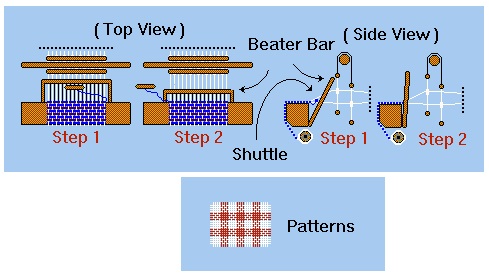
After the shuttle is passed and the weft thread pulled so there
is no slack, the beater bar is pulled forward to tap the weft
snug against the criss-cross of the warp threads. Then the
beater bar is dropped back, away from the weaver, and the warp
threads reversed by the heddle pulley action controlled by the
foot treads. The beater bar has a thin wire or reed to go
between each warp thread, and is not used with force but a
gentle tapping action. Different patterns can be woven into the
material by alternating colors in the warp thread and using a
number of shuttles - a checkerboard by alternating groups of red
and white warp threads and also alternating groups red and white
weft threads. The edge of the material should be kept trim, so
the material won't unravel, and when the material is removed
from the loom the warp threads are tied on both ends and can be
left as a fringe or woven back into the material with a needle
to secure them.
|

